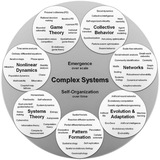💻 A comprehensive simulation on the #Ising_Model by Asher Preska Steinberg, Michael Kosowsky, and Seth Fraden, Physics Department, Brandeis University
🔑 The goal of this experiment was to create #Monte_Carlo simulations of the 1D and 2D #Ising model.
To accomplish this the #Metropolis algorithm was implemented in #MATLAB. The dependence of #magnetization on #temperature with and without an external field was calculated, as well as the dependence of the #energy, #specific_heat, and #magnetic_susceptibility on temperature. The results of the 2D simulation were compared to the #Onsager solution.
🔗 http://fraden.brandeis.edu/courses/phys39/simulations/AsherIsingModelReport.pdf
🔑 The goal of this experiment was to create #Monte_Carlo simulations of the 1D and 2D #Ising model.
To accomplish this the #Metropolis algorithm was implemented in #MATLAB. The dependence of #magnetization on #temperature with and without an external field was calculated, as well as the dependence of the #energy, #specific_heat, and #magnetic_susceptibility on temperature. The results of the 2D simulation were compared to the #Onsager solution.
🔗 http://fraden.brandeis.edu/courses/phys39/simulations/AsherIsingModelReport.pdf
Complex Systems Studies
Quantum Field Theory and Condensed Matter: An Introduction by Ramamurti Shankar (Cambridge Monographs on Mathematical Physics) 1st Edition
Providing a broad review of many techniques and their application to condensed matter systems, this book begins with a review of #thermodynamics and #statistical_mechanics, before moving onto real and imaginary time path integrals and the link between Euclidean quantum mechanics and statistical mechanics. A detailed study of the #Ising, #gauge-Ising and #XY models is included. The #renormalization group is developed and applied to #critical_phenomena, #Fermi_liquid theory and the renormalization of field theories. Next, the book explores bosonization and its applications to one-dimensional fermionic systems and the correlation functions of homogeneous and random-bond Ising models. It concludes with Bohm-Pines and Chern-Simons theories applied to the quantum Hall effect. Introducing the reader to a variety of techniques, it opens up vast areas of condensed matter theory for both graduate students and researchers in theoretical, statistical and condensed matter physics.
🌴 In a new paper, SFI External Prof Jon Machta and colleagues from UC Davis, show that one of the most famous models in statistical physics — the #Ising model — could be used to understand why pistachio trees bloom in synchrony.
https://santafe.edu/news-center/news/what-magnets-have-do-pistachios
https://santafe.edu/news-center/news/what-magnets-have-do-pistachios
santafe.edu
What magnets have to do with pistachios
<p>SFI External Professor Jon Machta and colleagues from the University of California, Davis, show that one of the most famous models in statistical physics, the Ising model, could be used to understand why pistachio trees bloom in synchrony.</p>
Real life #networks have #loops, and that means #recursion. Whether passing notes or infections, messages don't just wash across a graph. They swirl and eddy.
On a new paper in @ScienceAdvances co-authored by SFI's George Cantwell and Mark Newman:
https://t.co/b7sglS1qsw
#Ising
On a new paper in @ScienceAdvances co-authored by SFI's George Cantwell and Mark Newman:
https://t.co/b7sglS1qsw
#Ising
santafe.edu
Research brief: Can the ‘belief propagation’ algorithm accurately describe complex networked systems?
<p>In a paper published in <em>Science Advances</em>, University of Michigan and Santa Fe Institute researchers report a novel belief propagation algorithm for the solution of probabilistic models on networks containing short loops.</p>
